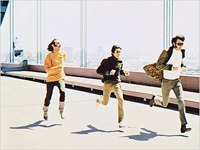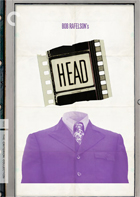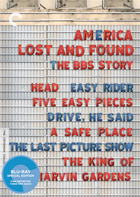Head [Blu-Ray]
|
 When U2 released their sixth studio album Achtung Baby in 1991, the band was fond of describing the distorted, opening guitar riffs on the first single "The Fly" as "the sound of four men chopping down The Joshua Tree." The band's desire to essentially destroy that for which they were best known and most celebrated in order to stake out new terrain was dangerous, although it ultimately helped them reach new levels of international superstardom, and they spent much of the next decade tweaking and playing with their rock-star image before returning to their core sensibilities in the 2000s.
When U2 released their sixth studio album Achtung Baby in 1991, the band was fond of describing the distorted, opening guitar riffs on the first single "The Fly" as "the sound of four men chopping down The Joshua Tree." The band's desire to essentially destroy that for which they were best known and most celebrated in order to stake out new terrain was dangerous, although it ultimately helped them reach new levels of international superstardom, and they spent much of the next decade tweaking and playing with their rock-star image before returning to their core sensibilities in the 2000s.
Interestingly enough, the Monkees, a prefabricated pop band assembled in 1966 for a television show by producers Bert Schneider and Bob Rafelson, had done something quite similar more than two decades earlier, but with quite different results. The Monkees--Peter Tork, Michael Nesmith, Micky Dolenz, and Davy Jones--reached the pinnacle of their stardom after only two years of their eponymous TV show, which had been inspired by Richard Lester's anarchic Beatles comedies A Hard Day's Night (1964) and Help! (1965). The Monkees were never taken seriously by rock critics because they did not develop organically, but were rather "assembled" by Schneider and Rafelson via Hollywood casting calls (it didn't help that Dolenz and Jones were actors who couldn't initially play any instruments, although Tork and Nesmith were both capable musicians). Nevertheless, they were branded "The Prefab Four" and dismissed by a music industry that was increasingly turning toward experimentation and social consciousness. That did not stop the Monkees from becoming a television phenomenon, and their melding of pop music and small-screen visuals served as a precursor to the music video and also helped launch a marketing craze that made everyone associated with the group extremely wealthy. When the TV show was not renewed in the fall of 1968, Rafelson, who was an aspiring film director and self-declared artist, decided that the best thing to do would be to make a feature film, not as the first brick in a potential new franchise, but rather as a wholesale, wink-wink deconstruction of the elaborate multi-media phenomenon he had helped to build. The result was Head, an irreverent, non-narrative, stream-of-consciousness lark that took the Monkees' TV show and turned it inside out with nonsensical skits intercut with Vietnam footage, cameos by Hollywood has-beens (Victor Mature, Annette Funicello, Timothy Carey) and counterculture heroes (Frank Zappa), and constant fourth-wall breaking references to its own artifice. Similar to U2's musical chopping down of the venerated Joshua Tree, Rafelson had the Monkees take a musical potshot at themselves early in the film with a new version of the well-worn "Monkees' Theme Song," which replaced the cheerfully sung lyrics "Hey, hey, we're the Monkees/And people say we monkey around/But we're too busy singing/To put anybody down" with a military-style chant that says "Hey, hey, we're the Monkees/You know we love to please/A manufactured image/With no philosophies." The result was a critical and commercial disaster, which turned Head into a little-seen curiosity piece that has since developed a rabid cult following. Critics who thought the Monkees were a farce to begin with had little patience for a film that revealed and then reveled in what they already knew and resented, and adolescents who loved the band's family-friendly rollicking on the small screen didn't know what to do with the film's sometimes angry tone, cultural potshots, and visual experimentations with rapid-fire editing and solarized color inversions. The title itself is an obvious nod to retooling the Monkees' image into some more countercultural than white bread, as it directly refers to the then-popular slang term for someone who uses drugs, although it has also been rumored that it was used primarily so that Rafelson and Schneider could advertise any subsequent film as being "from the producers who gave you Head." The screenplay, which was written primarily on acid by Rafelson and Jack Nicholson, who at the time was a struggling B-movie actor, relies on associational montage to provide transitions between the otherwise unrelated sketches that make up the majority of the running time. Various sequences find the Monkees in the middle of the desert, in the trenches of a war zone, trapped inside a vacuum cleaner, navigating a dank crypt, and, of course, playing various songs, including one at a concert that is followed by their rabid fans storming the stage and literally tearing them apart, their bodies having been replaced by plastic mannequins. The symbolic obviousness of that sequence is endemic to Head as a whole, as each sequence is designed to draw our attention to some facet of entertainment artifice, whether it be Dolenz storming off the stage during a Western skit or Nesmith arguing with Rafelson about the advisability of punching a woman (actually a man in drag) on camera. Like any film of this sort, parts of Head work and parts don't. There is an inherent curiosity quotient for any project this inherently whacked out, which helps smooth over the underlying rub that Rafelson is using the film to rather portentously blow his own horn in proclaiming that he was in on the joke from the start, which means that the joke is on us. The Monkees themselves are certainly game, especially since they had already wearied of all the potshots about their musical chops and prefabricated personas. They display the same sense of comical ease that made the television show so imminently watchable, but here it translates into something more desperate and edgy. Head is never really funny, but then again, it's not supposed to be. Any time we have the Monkees intercut with the infamous newsreel footage of General Nguyen Ngoc Loan assassinating a Viet Cong prisoner in the streets of Saigon (which makes me wonder how the ratings board, then in its infancy, could justify giving the film a G rating), you know you're not in Kansas anymore.
Copyright ©2010 James Kendrick Thoughts? E-mail James Kendrick All images copyright © The Criterion Collection | |||||||||||||||||||||||||||||||||||
Overall Rating:



 (3.5)
(3.5)
Subscribe and Follow
Get a daily dose of Africa Leader news through our daily email, its complimentary and keeps you fully up to date with world and business news as well.
News RELEASES
Publish news of your business, community or sports group, personnel appointments, major event and more by submitting a news release to Africa Leader.
More Information

 Head is availably exclusively via The Criterion Collection's six-disc box set America Lost and Found: The BBS Story, which also includes Easy Rider (1969), Five Easy Pieces (1970), Drive, He Said (1970), A Safe Place (1971), The Last Picture Show (1971), and The King of Marvin Gardens (1972).
Head is availably exclusively via The Criterion Collection's six-disc box set America Lost and Found: The BBS Story, which also includes Easy Rider (1969), Five Easy Pieces (1970), Drive, He Said (1970), A Safe Place (1971), The Last Picture Show (1971), and The King of Marvin Gardens (1972).